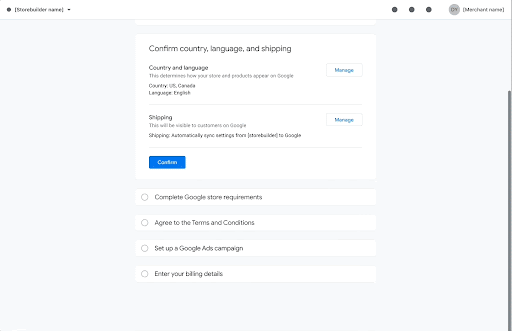关于本指南
本指南旨在为商店开设平台提供一系列适用于非付费商品详情和付费广告的集成最佳实践。本指南旨在帮助商店开设平台提供顺畅的体验,从而助力商家发展。本指南将重点介绍有效管理大量 Merchant Center 和 Google Ads 帐号所需的各种 Google API。在浏览本指南时,针对大多数部分,您应该都可以找到以下指南:
- 简介和业务影响
- 技术指南(API 等)
- 用户体验指南(附屏幕截图)
- 已知问题和提示
如何使用本指南
在浏览本资源时,您会发现创建强大基础集成的 5 个更广泛步骤:
- 账号开设
- 商品上传
- 数据质量 / 问题排查
- Ads
- 通报失准
每个步骤都包含需要实现的基本功能。大部分功能是必需的,但有些功能并非必需功能,具体取决于多种因素。这些目标取决于您所在的地理位置、商家的目标市场、您决定实施的方式以及要实施的购物计划。
新手入门用户体验设计指导原则
请务必打造一种新手入门体验,为那些希望在 Google 上展示其商品的商店开设平台商家提供指导,并帮助他们预防可避免的错误,为取得理想成效做好准备。
我们建议使用户体验统一非付费商品详情和付费广告新手入门要求,并在需要时提供可选的付费广告步骤(即制作付费广告,包括设置 Google Ads 广告系列以及输入结算详细信息)。
我们建议您在设计集成时了解 3 个特定的新手入门用户体验原则。
轻松掌握基本入门指导
我们建议您采取以下措施,帮助商家轻松上手:
简化加盟流程:我们建议只提供最基本的必需任务。
智能默认设置,始终可修改:设置配置时,请代表商家做出有根据的猜测,清楚说明相应选择,并允许他们进行修改。
单页式新手入门:最佳做法是将所有新手入门任务放在一个页面上。商家在开始初始配置时以及初始配置流程的任何阶段,都可以集中查看所有任务。
允许商家稍后完成复杂的任务:对于网站政策检查和配送设置,请允许商家在初始配置期间跳过此步骤,稍后再完成,具体请参见下文。然后提醒并引导商家在新手入门流程结束后满足相关要求。
情境指南
我们建议指导商家了解新手入门任务的影响,并且仅在与商家当前正在处理的任务相关时才提供简明的指南。
自适应
这些指南提供了分类方法,可以灵活应用,适用于各种商店开设平台。我们建议您根据集成情况进行调整,并且可以选择最适合其平台条件的选项。例如,对于开放资源商店开设平台,以及具有强大配送系统的商店开设平台,都有配送设置。

联系渠道
如果您有任何疑问或需要支持,请考虑使用以下选项:
Content API for Shopping 支持:如需技术支持,您可以与 Content API for Shopping 支持团队联系。
Google Merchant 支持:对于与 Merchant Center 和付费广告相关的问题,您可以通过此支持渠道获得支持。
Google 联系人 (POC):如果您有专门的 Google 联系人 (POC) 来为您的集成提供支持,如有任何问题,我们建议您直接与他们联系。
